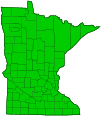common milkweed
(Asclepias syriaca)
Conservation • Wetland • Description • Habitat • Ecology • Use • Distribution • Taxonomy
Description |
Common milkweed is an erect perennial forb. A single stem rises from a long, creeping rhizome. It often forms colonies. The leaves and stems contain a milky juice. The stems are erect and unbranched. They are covered with short, matted or tangled, soft, woolly hairs. The leaves are opposite, thick, untoothed, 2½″ to 8″ long, 2¼″ to 4″ wide, and egg-shaped to elliptic or oblong. They are rounded at the base and taper to a point at the tip. They are attached to the stem on leaf stalks that are from less than ¼″ to over ½″ long. The upper surface is softly hairy, the lower surface finely woolly. The inflorescence is usually several dense, drooping, umbrella-shaped clusters (umbels) rising from the upper leaf axils. The clusters are 3″ to 4″ in diameter and erect on a hairy, 2″ long stalk. They typically have 20 to 130 flowers. The structure of the typical milkweed flower is unique and instantly recognizable. There are 5 petals bent backward at the base and hanging downward. Subtending the petals are 5 much shorter, light green, lance-shaped sepals. There are 5 stamens. Formed from the filament of each stamen is a petal-like appendage. The appendage consists of a tubular hood surrounding an awl-shaped horn in the center of the hood. The stamens and the stigma are fused together into a crown-like structure (gynostegium). Each stigma has a long slit designed to catch the legs of a pollinating insect. A small, dark, sticky gland above this slit is attached to pollen sacs from adjacent anthers. These glands are designed to break off as an insect pulls its leg free of the slit, and remain attached to the insects leg. The flowers are pollinated by larger insects strong enough to lift off with the pollen sacs attached. Smaller insects are caught in a death trap or leave behind their detached legs. The flowers of this plant are shaped like the typical milkweed flower. They are ⅜″ to ⅝″ tall and ¼″ wide. The petals are pink to reddish-purple. They bend backward at the base, hang downward, then curl upward near the tip. They are separated from the hoods by a short but distinct column. The horns are shorter than the hoods. They project from the hoods and are curved inwards. The flowers are highly fragrant, the scent noticeable from yards distant. The fruit is a fat, spindle-shaped pod. It is 3″ to 4½″ long and ¾″ to 1½″ thick. It is densely warty. It is held erect on a downward-pointing stalk. It opens on one side exposing the seeds to spreading by the wind. The seeds have a tuft of white, silky hairs at the tip. |
Height |
36″ to 72″ |
Flower Color |
Pink to reddish-purple |
Similar Species |
Clasping milkweed (Asclepias amplexicaulis) stems are hairless and glaucous. The leaves are rounded, not pointed, at the tip. They clasp the stem at the base, They are hairless and glossy on the upper surface, and are glaucous on the under surface. The leaf margins are strongly wavy. There is a single umbel appearing on a long stalk at the top of the stem. The umbel is erect and has 18 to 60 flowers. The petals are green tinged with red or purple. The horns are much longer than the hoods. The fruits are long, thin, and pointed and are not covered with warts. Purple milkweed (Asclepias purpurascens) stems are unbranched and are covered with short, fine, soft hairs. The umbels are erect, appear near the top of the stem, and have up to 50 flowers. Sullivant’s milkweed (Asclepias sullivantii) is a much shorter plant, 1′ to 3′ tall at maturity. The leaves and stems are hairless. The leaves are acute-tipped, ascending, with a reddish central vein. The umbels are looser, on a hairless stalk, and have 15 to 40 flowers. The flowers are larger. The fruit is narrower and smooth or slightly warty. Swamp milkweed (Asclepias incarnata var. incarnata) stems are usually branched above the middle, and are hairless except for a vertical line of hairs on each side between the leaf nodes on the upper half. The umbels have 20 to 30 flowers. The horns are much taller than the hoods. The fruits are narrow, not fat, and are smooth, not covered with warts. It is usually found in wet areas. |
Habitat |
Dry to wet. Meadows, fields, prairies, roadsides. Full to partial sun. |
Ecology |
Flowering |
June to August |
Faunal Associations |
Milkweeds are the only plants that Monarchs lay their eggs on. The eggs are laid on the underside of healthy young leaves. |
Toxicity |
This and other milkweeds contain cardiac glycosides and may be poisonous to both humans and livestock. |
Pests and Diseases |
|
Use |
|
Distribution |
||
|
Sources |
|
| 11/18/2024 | ||
Nativity |
||
Native |
||
Occurrence |
||
Common and widespread |
||
Taxonomy |
|
Kingdom |
|
Subkingdom |
Pteridobiotina |
Phylum |
Tracheophyta (Vascular Plants) |
Class |
|
Order |
Gentianales (Gentians, Dogbanes, Madders, and Allies) |
Family |
Apocynaceae (dogbane) |
Subfamily |
Asclepiadoideae (milkweeds) |
Tribe |
Asclepiadeae |
Subtribe |
Asclepiadinae |
Genus |
|
Subordinate Taxa |
|
|
|
Synonyms |
|
Asclepias apocinum Asclepias capitellata Asclepias cornuti Asclepias elliptica Asclepias fragrans Asclepias grandifolia Asclepias intermedia Asclepias kansana Asclepias pubescens Asclepias pubigera Asclepias serica Asclepias syriaca f. inermis Asclepias syriaca f. leucantha Asclepias syriaca var. kansana |
|
Common Names |
|
broadleaf milkweed common milkweed cotton weed silkweed Silky swallowwort Virginia silk |
|
Glossary
Axil
The upper angle where the leaf stalk meets the stem.
Glaucous
Pale green or bluish gray due to a whitish, powdery or waxy film, as on a plum or a grape.
Gynostegium
A crown-like structure of plants of the genus Asclepias formed by the fusion of the anthers with the stigmas.
Linear
Long, straight, and narrow, with more or less parallel sides, like a blade of grass.
Rhizome
A horizontal, usually underground stem. It serves as a reproductive structure, producing roots below and shoots above at the nodes.
Umbel
A flat-topped or convex, umbrella-shaped cluster of flowers or buds arising from more or less a single point.
Visitor Photos |
||
Share your photo of this plant. |
||
This button not working for you? |
||
Alfredo Colon |
||
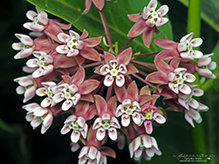 |
||
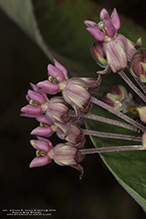 |
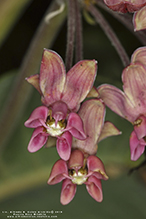 |
|
Nancy Falkum |
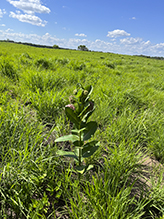 |
Common Milkweed At TNC KWD Cox Unit |
Bill Reynolds |
||
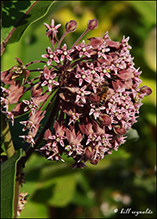 |
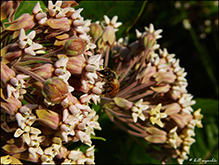 |
|
MinnesotaSeasons.com Photos |
||
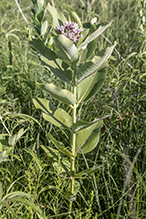 |
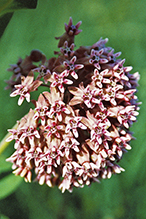 |
|
Plant |
Inflorescence | |
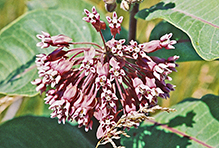 |
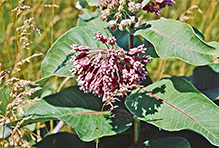 |
|
Plant |
Inflorescence | |
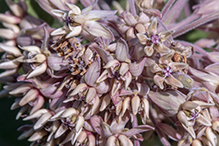 |
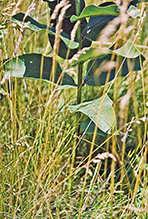 |
|
Flowers |
Leaves | |
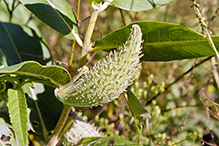 |
||
Fruit |

Slideshows |
Asclepias syriaca |

|
Common Milkweed |

|
About
Asclepias syriaca |
Asclepias syriaca (Common Milkweed) |
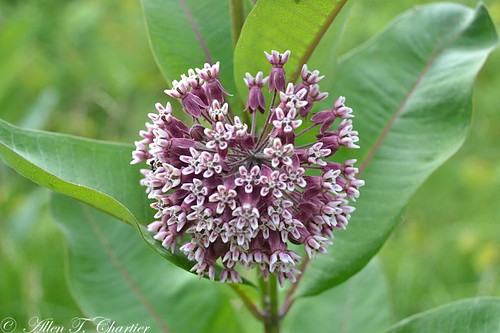
|
Asclepias syriaca COMMON MILKWEED |
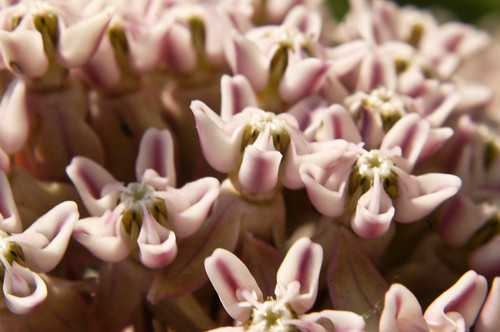
|
A. syriaca |
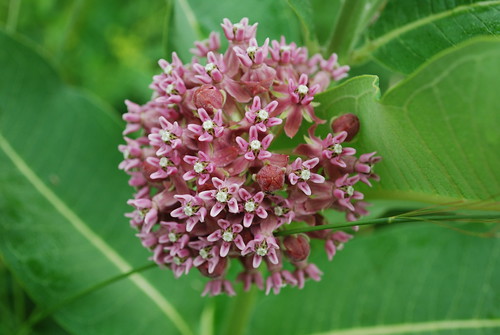
|
About
Common Milkweed |

Visitor Videos |
||
Share your video of this plant. |
||
This button not working for you? |
||
|
Other Videos |
||
Minnesota Native Plant - Common Milkweed (Asclepias Syriaca) |
About
Published on Jun 30, 2013 The native plant today is the Common Milkweed (Asclepias Syriaca). Common throughout all of Minnesota and the host plant for the Monarch butterfly. |
Common Milkweed (Asclepias syriaca) |
About
Published on Aug 24, 2012 Common Milkweed (Asclepias syriaca) |
Milkweed Patch |
About
Published on Sep 6, 2013 This milkweed patch has hundreds of butterflies nectaring on the Common Milkweed (Asclepias syriaca) blooms. Taken just south of Raleigh, North Carolina, on September 5, 2013. |
Honeybees forage on Common Milkweed |
About
Uploaded on Jun 27, 2011 Honeybees forage in common milkweed (Asclepias syriaca) as Killdeer Plains Wildlife Area in Wyandot County, Ohio, USA. A bobolink sings in the background. |
Common Milkweed (Asclepias syriaca), Close-up Seeds |
About
Published on Sep 29, 2012 Photographed at the Turtle River State Park, North Dakota (29 September 2012). |

Visitor Sightings |
||
Report a sighting of this plant. |
||
This button not working for you? |
||
Alfredo Colon |
Location: Albany, NY |
 |
| Nancy Falkum 6/26/2022 |
Location: Weaver Dunes Preserve, Cox Unit Common Milkweed At TNC KWD Cox Unit |
 |
| Alfredo Colon 8/22/2019 |
Location: Woodbury, Minnesota |
 |
| Karna Berg 8/30/2017 |
Location: South St. Paul I have hundreds on my milkweed in South St. Paul. Should I kill them? |
|
| Marilyn Carlson 8/30/2017 |
Location: Annandale, MN When can I safely pull out the milkweed plants that are growing in my flower garden? I would really like to get milkweed growing along side our driveway ditch so it can grow basically wild with no problem of being cut or pulled out or sprayed. As it is really starting to take over my flower garden. If I take the milkweed pods/seeds and sprinkle them in this area what are the chances of the growing next spring? We are seeing some Monarchs at this time (8-30-2017) |
|
MinnesotaSeasons.com Sightings |
||
Avon Hills Forest SNA, North Unit Beaver Creek Valley State Park Bertram Chain of Lakes Regional Park Blazing Star Prairie Addition Preserve, South Unit Carpenter St. Croix Valley Nature Center Carver Highlands WMA, South Unit Charles A. Lindbergh State Park Clifton E. French Regional Park Clinton Falls Dwarf Trout Lily SNA Felton Prairie SNA, Bicentennial Unit Forestville/Mystery Cave State Park Hardscrabble Woods / MG Tusler Sanctuary John Peter Hoffman Spring Brook Valley WMA Kellogg Weaver Dunes SNA, Kellogg Weaver Unit Lake Alexander Woods SNA, South Unit Mary Schmidt Crawford Woods SNA Minnesota Valley NWR, Long Meadow Lake Unit Minnesota Valley NWR, Louisville Swamp Unit Minnesota Valley NWR, Rapids Lake Unit Minnesota Valley NWR, Wilkie Unit Mound Spring Prairie SNA, North Unit Northern Tallgrass Prairie NWR, Hoffman Unit Northern Tallgrass Prairie NWR, Pavia Unit Northern Tallgrass Prairie NWR, Rengstorf Unit Northern Tallgrass Prairie NWR, Spieker Unit Northern Tallgrass Prairie NWR, Touch the Sky Prairie Unit P.N. and G.M. Nelson Wildlife Sanctuary Pankratz Memorial Prairie, North Unit Pembina Trail Preserve SNA, Crookston Prairie Unit Prairie Creek WMA, Koester Prairie Unit Richard M. & Mathilde Rice Elliott SNA Robert Ney Memorial Park Reserve Sand Prairie Wildlife Management and Environmental Education Area Two Rivers Aspen Prairie Parkland SNA Verlyn Marth Memorial Prairie SNA |

|
Created: Last Updated: © MinnesotaSeasons.com. All rights reserved. |
